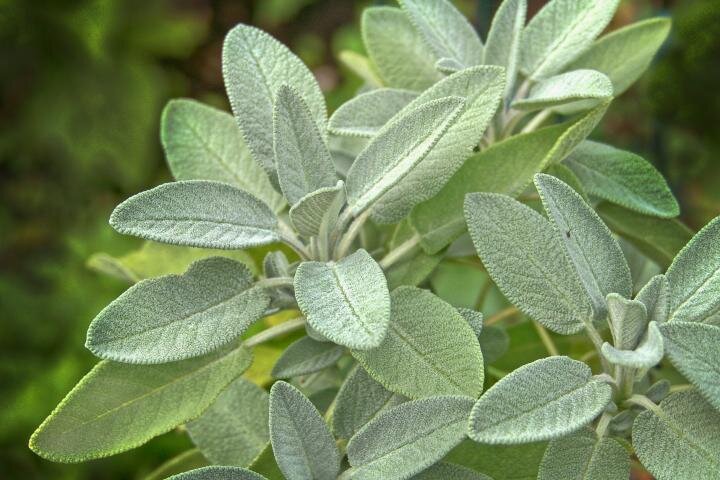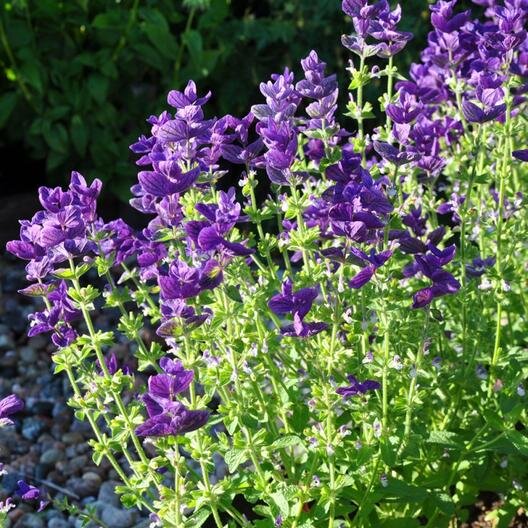Sage

Sage is one of the most useful plants - an ally for all
When sage rather insisted to be the next herb to be written about, I assumed I would write about White Sage and my best friend Melinda, a drummer and healer who wanted to change her name to Sage but crossed to the Other Side before we could put the re-naming ritual together.
Tenuously but dutifully, I grabbed my pencil and turned my ear to the Muse to record sage’s story when suddenly, I was besieged by the Many Faces of Sage.
My Goddess, Sage has much to say! After all, Salvia is the largest genus in the mint family, Lamiaceae, with nearly a thousand species of shrubs, herbaceous perennials, and annuals.
Sage has a fascinating lore. In the 10th century C.E., Moorish physicians believed that sage could extend life to the point of immortality. The French believe that sage can ease grief, which is the reason it is sown in graveyards there. Traditional Chinese medicine uses sage to treat insomnia, depression, gastrointestinal complaints, mental illness, menstrual complaints, and mastitis In Ayurveda medicine, sage is used to treat hemorrhoids, gonorrhea, vaginitis and eye disorders. Sage is associated with Jupiter, Venus, Artemis, Diana and Hygeia. Its botanical name, salvia, is derived from the Latin word salvus, meaning “healthy” or “salve” and refers to the plant’s curative powers.
Salvia Officinalis
First, it was Garden Sage that floated to my awareness and reminded me of her medicinal properties for healing. Salvia Officinalis is commonly known as Sawge, Red Sage, Broad-leaved White Sage, Narrow-leaved White Sage and Salvia salvatrix . A sage infusion (one ounce of dried herb in boiling water, covered for at least four hours) works wonders on fevers, headaches, sore throats, and indigestion. Garden Sage is considered anti-inflammatory, antiseptic and antibacterial, tastes good, and is used in a variety of culinary dishes from eggs to poultry to polenta.
Clary Sage

Then Clary Sage spoke up and said, “I am wonderful as an essential oil.” And so it is! The leaves and flowers of clary sage are steam distilled and the oil is added to soaps, detergents, lotions, and perfumes, as well as muscatel wine, frozen dairy desserts, baked goods, and condiments.
The herb derives its name from the Latin clarus, meaning, “clear,” and was nicknamed “clear eyes” during the Middle Ages for its ability to clear tired or strained eyes and blurred vision. It is also used to calm the nervous system, and sage addresses menstrual issues, boosts the libido, relieves headaches, back pain and stiffness, reduces blood pressure, stimulates hair growth, limits the sebum produced in scalp and treats dandruff, regulates oil production and reduces inflammation that contributes to dermatitis. It is considered a fixative, and adds a warming, middle note with a dry, musky, bittersweet floral scent.
Some of my other favorites include Salvia divinorum, or diviner's sage, sometimes cultivated for psychedelic drug effects; Salvia elegans, the pineapple sage, widely grown as an ornamental shrub, with pineapple-scented leaves; and Salvia hispanica, commonly known as chia, which produces edible seeds which are high in protein and in the omega-3 fatty acid, α-linolenic acid (ALA); Salvia miltiorrhiza, Chinese, Red sage, Danshen medicinal herb and Salvia guaranitica or hummingbird sage.
White Sage
But of all the many sage varieties, I have the strongest connection with White Sage, the kind many of us have burned to purify and add a layer of protection to our rituals as well as everyday living. It has been used for centuries by indigenous Americans.

I recently incorporated white sage as a primary ingredient to create an Earth Blessing Pouch at the final ceremony for my dear friend Melinda. The ritual was adapted from a Southern California Tongva tobacco blessing ritual, given to me by spiritual leader Jimi Castillo at the onset of a Naming Ceremony where Melinda and I bestowed each other with sacred names thirteen years ago.
Prior to the ceremony, I asked the guests to bring dried herbs with them, such as sage, mint, lobelia or lavender. I then invited them to the altar where I had a large bowl of tobacco and sage. Our friend Daryl — a Lakota Sun Dancer and Pipe Carrier — sang songs while the guests poured their bags of dried herbs into the bowl.
I then added Melinda’s dried herbs that she had personally used for infusions and other healing purposes. We stirred the bowl and continued to sing and chant. The guests returned to the altar to receive a sage smudging and scoop a bag of herbs into a prepared muslin pouch, which they were invited to keep on their altar or sprinkle as an offering to the earth.
Bringing Sage Into Your Life
The many varieties of genus Salvia are attributed to its unusual pollination mechanism, which easily released by many bird and bee pollinators of varying shapes and sizes. This biodiversity is based on a congruous relationship between the plant and birds and bees.
Above all, sage teaches how to use the power of adaptability and remaining open can spread love and healing.
THIS ARTICLE WAS ORIGINALLY PUBLISHED IN WITCHES AND PAGAN MAGAZINE #33